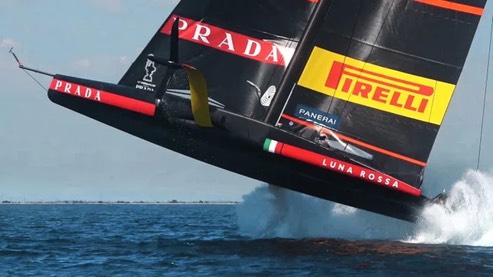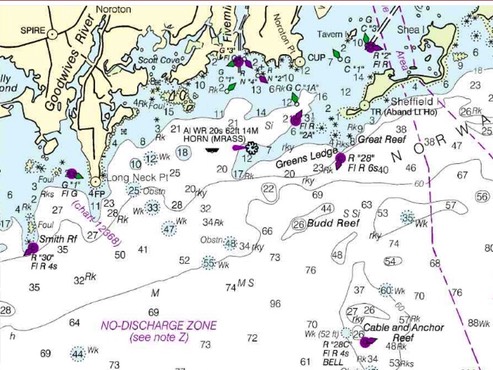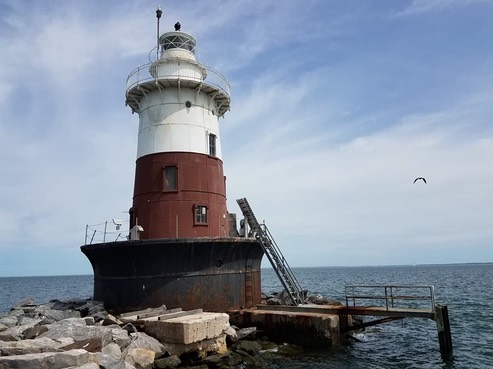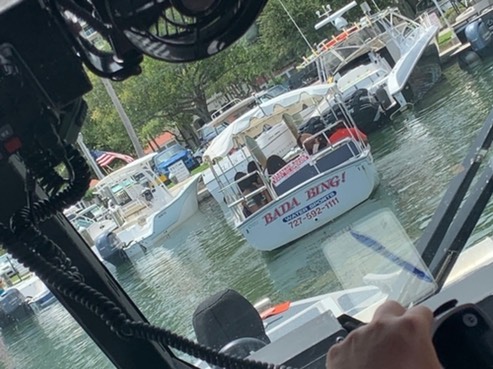Blog
Navigation Safety
Tidal Current
We call our inlets “passes” here on the Gulf Coast. Being relatively deep water, Pensacola Pass is fairly tame compared to the two shallow-water passes along the coast on either side of Pensacola: Alabama Point (Perdido) Pass to the West, and East Bay (Destin) Pass to the East. When the Tidal Current is ebbing against a Southerly wind is not a good time to be in either Perdido or Destin passes. Here is a good example why:
If you have to navigate any shallow-water pass, be sure to check the local Tide and/or Tidal Current Tables first. Unfortunately, NOAA does not publish online tidal current information for either Perdido or Destin passes, but you can get a rough estimate of the flood and ebb by checking the Tide Tables’ time for the High and Low Stand at those locations. It takes some practice, and remember that it’s only an estimate!
If you see breaking waves in the pass, you know it’s not a good time to be going in or out!
/fl
America’s Cup
Ready About

The dangers involved sailing the new America's Cup boats have been revealed by a picture showing Luna Rossa hurtling skywards.
A jibe is one of those maneuvers that require proper focus and management, in order to be safely completed. Things can get really exciting if/when the rudder comes out of the water during the maneuver!
/fl
Navigation
Grounding on Long Island Sound
Here is yet another case regarding why I claim that 'navigation waste is hazardous waste’; In this case a new $300,000 motor boat being delivered from Stewart, Florida to Portsmouth, New Hampshire winds up on a well-marked, well-charted shoal.
Anyone who has been sailing (or motoring) long enough has no doubt experienced at least one time when they felt overwhelmed with unforeseen conditions, be it weather conditions or mechanical failure. But, here we have a case where a boat runs over a marked obstruction in broad daylight. What happened?
The story, as it appeared in the Stamford Advocate:
STAMFORD — A New Hampshire man and his delivery captain are safe following a harrowing rescue off Sheffield Island Wednesday morning in a newly purchased powerboat he was motoring from Stuart, Florida home to Portsmouth.
Sgt. Peter Lapak, head of the Norwalk Police Department’s Marine Division, said it was a particularly difficult rescue. As the tide came up the 39-foot boat, valued at $300,000, sank, right after the rescue was made, Lapak said.
“In my whole career this was one of the worst ones, one of the most dangerous ones because of where we had to go, on top of the reef, and the sea conditions — the water was really cold,” said Lapak, a 26-year veteran of the Marine Division, about an hour after returning to shore from the rescue. “I’m really glad the guys were OK. They can get another boat.”
Norwalk Police Lt. Jared Zwickler said the marine unit responded to the call of a boat taking on water at about 8:15 a.m.
Boat owner Greg Mahanna, 54, from Portsmouth, and 61-year-old delivery captain Tom Raynor, from York, Maine, were were rescued and brought back to shore, said Norwalk Marine Officer Michael Silva.
Coast Guard Lt. Jennifer Sheehy said a distress call from the powerboat reported that the vessel had hit a submerged rock and was taking on water off the Norwalk island.
The powerboat ran aground in the area of Great Reef, just south of the western point of Sheffield Island. The area is known to be treacherous, especially for boaters unfamiliar with that particular bit of island coastline.
“It is a huge pile of rocks that is invisible at high tide and potentially deadly,” Lapak said. “It has claimed a lot of boats over the years.”
The tide was rising at the time of the accident.
Knowing where the boat had run aground, Lapak and officer Michael Silva chose to pilot the unit’s rigid inflatable boat, which has a shallow draft, out of Norwalk Harbor’s western entrance north of Sheffield Island. But when Lapak made the turn out into the Sound, a stiff southeast wind was pushing high waves at them. Because the shipwrecked boaters reported they were sinking, Lapak said he had to throttle the open lightweight craft through the high seas, launching it out of the water a couple times, causing some clamps holding the center console to the deck to snap.
Once he got near the boat, Lapak positioned the police craft to allow the wind and waves to push it alongside the cabin cruiser. Having raised the props to his outboard motors, he was able to drift onto the other boat and pick the two men up. After pushing off the sinking vessel, he allowed his boat to drift over the reef before putting his motors back in the water and transferred the men to a waiting boat to bring them in.
Lapak said Sea Tow, a company that recovers and tows disabled boats to safety, was working out a plan to recover the boat.
Reached in New Hampshire later on Wednesday, Mahanna said that he and Raynor were about a day away from ending their trip to Portsmouth.
After making their way up the east coast via the Inter-Coastal Waterway, the pair began Wednesday motoring out of a calm Manhasset Bay on the north shore of Long Island, headed to the Cape Cod Canal. But once on the Sound, Mahanna discovered his marine forecast for the day, which predicted one-foot seas, was way off.
“We were getting totally pounded by five- to seven-foot waves,” in a stiff southeast breeze, he said.
He decided to head for the south shore of Connecticut in hopes of staying out of the wind and waves. But while hugging the Connecticut shore he got too close to Sheffield Island and hit Great Reef. Mahanna, who said the boat was well insured, added he is an experienced sailor who through the wind and waves did not see the rock on the electronic GPS map screens he had on the bridge.
“We ended up on the top of the ledge sitting there,” he said. “I’ve been a boater for 35 years. I’m not an idiot who goes out and buys a new boat and doesn’t know what they are doing.”
That last comment in the story is an apparent tell, however results are often the same for those who don’t know what they are doing and those who don’t pay attention to what they are doing!
The news article states that the boat operator “did not see the rock on the electronic GPS map screens.” The article does not reveal the type of chart program that was being used. A section of NOAA Chart 12363 shows us that the “Greens Ledge/Great Reef” rocks that the vessel hit are charted:

This is conjecture, but I’m guessing that the boat operator had intended to proceed to the channel marked in the upper right portion of the above chart, probably in order to get out of the weather conditions that had been encountered. If that is in fact the case, how did he miss seeing this?:

Clearly marked on the chart is this 62’ structure which marks a safe path to the channel.
A good lesson for everyone to remember is that Aids to Navigation (ATON’s) are designed to be used WITH a nautical chart. The chart will usually give a brief description of what is depicted thereon—and what you are looking at on the water. Why is that important? Because, it is sometimes difficult to distinguish by “eyeball” between a “channel” marker (such as the “2A” above) and a “coastal” marker (such as the “28” above)—when operating in unfamiliar areas.
Take the safe route! As Ranger Doug says “it may not be the shortest way, but it’s the cowboy way."
/fl
Law and Order
Another Expensive Lesson
Serious business is taken seriously!

ST. PETERSBURG, Fla. — The Coast Guard terminated an illegal charter Saturday near Demens Landing Park.
A Coast Guard Station St. Petersburg 29-foot Response Boat—Small law enforcement crew terminated the voyage of a 21-foot uninspected passenger vessel with 9 passengers for hire.
The violations include:
Violation of 46 C.F.R. 15.515B for not having a credentialed mariner in control while operating a small passenger vessel.
Violation of 46 C.F.R. 176.100 (a) for not having a valid Certificate of Inspection.
Violation of 46 C.F.R. 16.201 for failure to have a drug and alcohol program.
Violation of 46 C.F.R. 170.120 for failure to have a valid stability letter.
During the course of the boarding, the boarding team determined the operator of the vessel was not the holder of a Coast Guard Merchant Mariner Credential. Uninspected passenger vessels are only permitted by Coast Guard regulations to carry six passengers for hire with a master who holds a Merchant Mariner Credential.
"The Coast Guard will continue to aggressively pursue vessel operators who needlessly place the lives of patrons at risk by not complying with Coast Guard passenger vessel regulations," said
Mr. Brian Knapp, Senior Investigating Officer at Coast Guard Sector St. Petersburg. "We urge anyone paying for a trip on a passenger vessel to ask to see the Merchant Mariner Credential of the vessel operator to verify their captain is properly credentialed by the Coast Guard. Additionally, when chartering a boat with more than six passengers ask to see the Coast Guard’s Certificate of Inspection. If the operator cannot produce a Merchant Mariner Credential or a Certificate of Inspection, don’t get on the boat.”
Owners and operators of illegal charter vessels can face maximum civil penalties of over $50,000 for illegal passenger-for-hire operations. Some potential fines for illegally operating a charter vessel are:
Up to $18,477 for failure of an inspected vessel to be under the control of an individual with the appropriate Coast Guard license.
Up to $7,250 for failure of operators to be enrolled in a chemical testing program.
Up to $4,685 for failure to provide a Coast Guard Certificate of Inspection for vessels carrying more than six passengers.
Up to $15,995 for failure to produce a valid Certificate of Documentation for vessels over 5 gross tons.
Up to $11,712 for failure to have been issued a valid Stability Letter prior to placing vessel in service with more than six passengers.
$58,119.00 in potential civil penalty! That would get your attention!
Since the Coast Guard has been aggressively enforcing laws against illegal charters for well over a year now in Florida, you would think that everyone would have gotten the word? Maybe there are some people who just don’t care? If they didn’t before, I bet that there are several that do now.
/fl
